With the numbers of those infected by the Covid-19 coronavirus rising inexorably every day, it is increasingly clear that disaster is possible for significant parts of the countries that make up 70 percent of Asia’s population unless authorities can find ways around it.
The peril was encapsulated in a distressed call from the wife of a carpenter named Tony in the southern Luzon town of Silang on March 22, asking if there was any work, any work at all that her husband could do. They had nothing to eat, not even dried fish or rice, for their children. The government did later come to the rescue with 2 kg of rice available to the family and other foodstuffs. Significant numbers of Filipinos make so little money that they buy their food by the day.
That was just 10 days after Philippine President Rodrigo Duterte ordered a lockdown of domestic air, land and sea travel to and from Metro Manila, the national capital region, until April 14. The lockdown was extended further, bringing all economic activity to a halt in a country where 26.7 percent of the workforce is employed in “elementary occupations” – pickup labor, with almost none of them with any more resources than Tony and his wife. How much strain those handouts of food and other items will place on government resources is unsure. There are additional concerns, according to a study published on March 22, that the virus could collapse the country’s medical system if it gets out of hand.
Asia in distress
Nor is the Philippines alone. What that means is that a lockdown of any sort of people with no resources is going to have an inordinate impact. The unpalatable alternative, as Asia Sentinel co-editor Philip Bowring reported on March 19, is to allow economic activity to resume with the hope that the virus will probably leave the youngest and healthiest and but raises the possibility it could sweep the elderly and ill into the grave.
What follows is a partial look at some of the countries across the region bracing for trouble. For far too much of the region, any kind of lockdown is going to have an enormous impact. An estimated 33 percent of India’s 1.3 billion population is composed of casual labor, with little economic cushion and little access to intensive medical care. In Pakistan, casual labor comprises 59 percent of the country’s 233 million people.
In Myanmar, 26 percent of the country’s 56 million people live below the poverty line, with an estimated 40 percent involved in casual labor. Some 24 percent of Bangladesh’s 162 million people live below the poverty line. Some 51 percent of Indonesia’s 280 million population are casual workers or self-employed. The United Nations estimates that 100 million people are living in war zones across the planet with inadequate medical care, unsanitary conditions and lack of proper nutrition.
The odds that any of those below the poverty line have the reserves to last a month in which there would be no transport to jobs that in any case would probably be frozen are almost nonexistent. That makes lockdowns across Asia a recipe for disaster. Economies have come to a stop in many countries, with China remaining the hardest-hit although its draconian methods appear to have mostly arrested the spread.
The statistics published in real-time by a website called Worldometer tell a frightening story. The virus has spread to 195 countries or territories. A handful – Singapore, Hong Kong, South Korea, Taiwan and possibly China, although the statistics are bewildering, have apparently got it under control with the kind of measures that Duterte is trying in the Philippines, although the Philippines lacks the resources of the better-developed economies. These methods required checking every potentially infected person, tracking them and their relatives, isolating suspected cases and providing intensive medical care for those infected.
That has left Singapore with 455 cases and two dead; Hong Kong with 318 cases and four dead; South Korea with nearly 9,000 cases and 111 dead, an indication that their medical systems are doing a superb job. But along with Germany with more than 29,000 cases and only 123 dead, they are outliers. China says they have topped out with 81,093 cases and 3270 dead.
Now the less-rich countries are starting to pay the price in terms of medical personnel who have caught the virus and died from it.
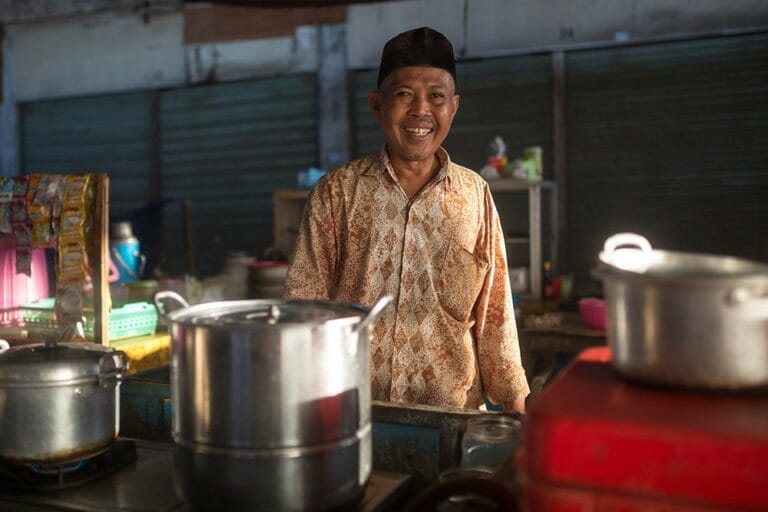
Traditional Indonesian morning market on Lombok island, Indonesia. Image: CatwalkPhotos / Shutterstock.com
Indonesia
So far, Indonesia, which didn’t acknowledge the existence of the virus in the country until March 2, has lost three healthcare workers including an ear, nose and throat specialist, a 34-year-old neurologist and a 70-year-old surgeon. The country seems almost oblivious to the pandemic, with one businessman who offered help to the government saying they seem incapable even of accepting private help. Religious ceremonies continue to be held with thousands of participants even though the government is suggesting that everyone conduct social distancing. On March 25, the Nyepi festival in Bali is expected to draw thousands.
Moreover, in the near future, the country will face the Ramadan fasting month followed by Eid al-Fitr, in which people from all over the country return to their hometowns. Religious events are a challenge for Indonesia in preventing the spread of the coronavirus now and in the near future. Indonesia now has a 9.3 percent death rate from the coronavirus, the highest in the world, which medical experts say is due to the fact that only a fraction of cases has been detected. One told local media that one death could correspond to as many as 1,000 undiscovered cases.
The health ministry last week forecast a possible 700,000 cases, an impossible strain on the health system. According to a Jakarta Post dispatch, a hospital crisis is looming over the combined capacity of the 132 referral hospitals designated to treat patients, protective gear for medical workers is in short supply in both referral and regular hospitals across the country and medical workers are often in the dark about whether they are treating actual Covid-19 patients. Infections account for only 2 cases per million population at the moment. There is some hope that the virus can’t survive sustained temperatures over 28 degrees centigrade, but that hasn’t been proven yet.
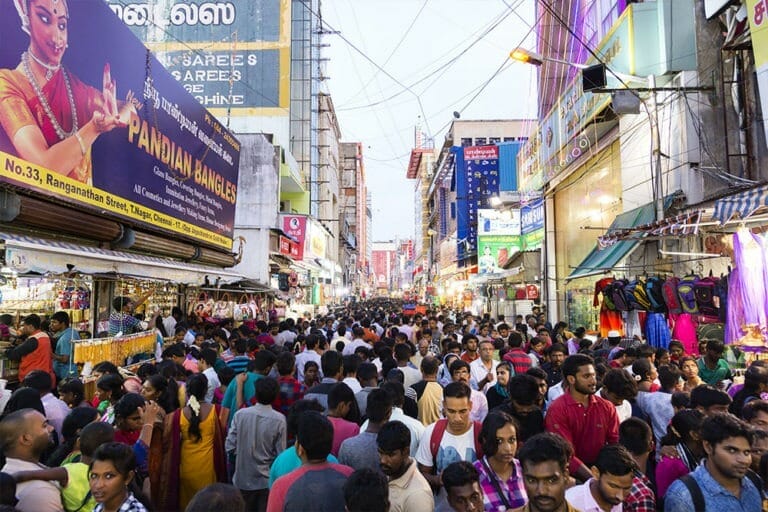
A crowded shopping street in Chennai City, India.
India
Over the weekend, cases started to spike, reaching 500 on March 24, prompting authorities to announce a lockdown in dozens of cities and districts until March 31. The central government has urged state governments to enforce the lockdown in 75 districts where it has been announced. The center has also asked respective state governments to take legal action against those who violate the prohibitory orders.
Although the government claims to have enough testing kits, reports on Twitter have indicated that the claim is hollow. Authorities have banned gatherings of more than five people in several states including Maharashtra, the worst affected with 89 cases. The southern state of Kerala, which has been lauded for its proactive approach to the pandemic early on, has 67 cases. A large section of the state’s residents works abroad, mainly in the Gulf. In the financial hub of Mumbai, Maharashtra’s capital, suburban trains, which usually carry 8 million people a day, were suspended until the end of the month.
Markets bled as stocks extended declines when trading resumed after a system-wide halt, and the rupee hit a new low following the lockdown in most of the country. The Confederation of All India Traders (CAIT) on March 23 urged Finance Minister Nirmala Sitharaman to extend till June 30 the date for filing income tax and GST returns in view of the pandemic.
Prime Minister Narendra Modi said on Monday that many Indians aren’t taking the lockdown seriously. “Please save yourself, save your family, follow the instructions seriously,” he said on Twitter. He also urged India Inc to maintain the supply of essential commodities and asked them not to indulge in job cuts despite the crisis. Several states including Maharashtra and Punjab imposed curfew saying people have been recalcitrant and are not following rules imposed by the authorities to control the spread of the deadly virus.
Modi also met with representatives from industry bodies and local Chambers from 18 across the country via video conferencing. He exhorted industry stakeholders not to cut their workforce in spite of the negative impact on business. Working from home, social distancing remains a big weapon in the fight against Covid-19, he said.
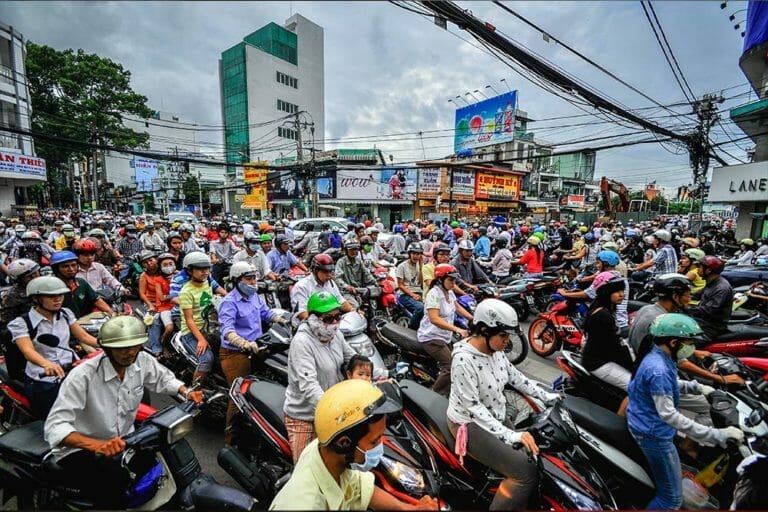
Saigon (Ho Chi Minh City), Vietnam. Ho Chi Minh is the biggest city in Southern of Vietnam. Image: weltreisendertj / Shutterstock.com
Vietnam
Vietnam has so far recorded only 123 cases of the Covid-19 virus and no deaths. Only two of those 123 cases are recorded as critical, which is almost certainly an unrealistic picture. Officials claim it was rigorous Chinese-style controls put in place in what they call a “Tet offensive,” a throwback to the 1968 assault by North Vietnamese soldiers and their allies, the Viet Cong, against US troops. Despite enormous losses, the offensive shocked the United States and played a major role in bring the war to an end.
Beginning in February, instead of implementing mass testing, Vietnamese official instead isolated those infected, aggressively traced their contacts, implemented forced quarantines and drafted retired nurses, doctors and medical students in the fight against the pandemic. The government introduced mandatory 14-day quarantines for all inbound travelers and canceled all foreign flights including all flights to and from China, where the virus originated. Schools in both Hanoi and Ho Chi Minh City as well as most other provinces have been closed and festivals and conferences have been postponed.
Statistics on the virus are unreliable everywhere, partly because the incubation period for infection is so long – up to 14 days or more – and because of the difficulty in gathering accurate reports. Highly modern economies with excellent health facilities and the most stringent methods of fighting the pandemic as well as featuring superb reporting facilities including Singapore, Hong Kong, South Korea and China continue to report cases. It is difficult to believe that Vietnam, with a population of nearly 98 million scattered over a 1,650 km length, much of it in deep poverty, can realistically expect the infection rate to stay at its current level. Nonetheless, officials say their approach has worked and will continue to work.
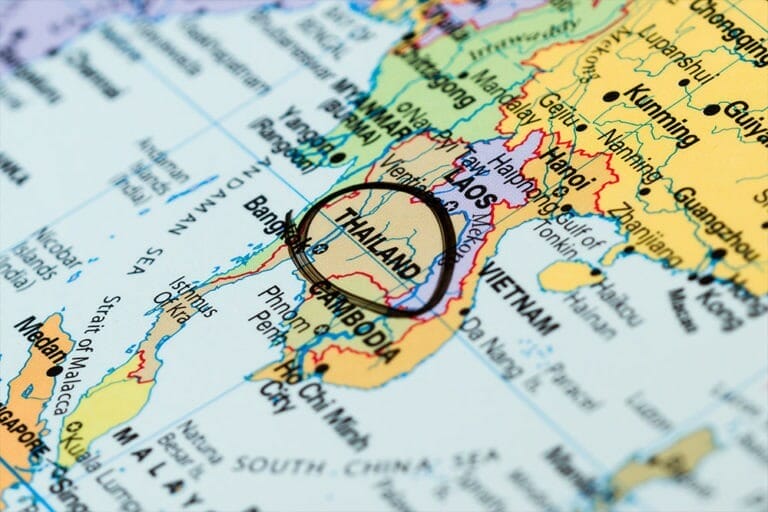
Close up of Thailand on map of Southeast Asia
Thailand
The Thai government is between a rock and a hard place. A lockdown would seriously hurt many families who live hand to mouth. They couldn’t survive without any income for more than a couple of days. Any lockdown would have to be accompanied by financial assistance immediately. This is probably why the government has implemented restrictions in stages. All department stores and shopping centers are now closed in the greater Bangkok area. The government has disinfected the city streets of most towns and cities, but it’s questionable what benefit this has been.
The first case outside of Wuhan appeared in Thailand in January. As of the time of writing, there are 721 confirmed cases, with one death. However, with very limited testing, less than 0.1 percent of the population has been tested, there are around 10,000 suspected cases. Tests are expensive, with public and university hospitals charging THB3,000-6,000 (US$91-182) and private hospitals THB 6-18,000. Foreigners in private hospitals are also in many cases charged a higher price, in Thailand’s controversial dual-pricing policy. The government will only provide free tests for Thai nationals who have symptoms, who test positive, have been in a public area like a Muay Thai stadium, and who have not traveled overseas recently.
Each day an additional 100 plus cases are confirmed. Deputy Prime Minister and health minister Anutin Charnvirakul blamed infections on “dirty Caucasians,” Although official statistics indicate infections have come through Chinese visitors and Thai Nationals who visited China, Japan, South Korea, Iran, and Malaysia. Only 10 cases originated in infections from Europe, and only nine have been Europeans. Some reports say Caucasians have been banned from shopping centers, visited by health authorities at their homes, and told to leave hotel accommodation.
Even though Prime Minister Prayuth Chan-ocha was recently briefed by top Thai doctors that not locking down Thailand would lead to more than 7,000 deaths, the government has been reluctant to act until last week when the Buriram governor locked down his own province. The northern city of Chiang Mai has closed all restaurants and entertainment venues.

Malaysian flags waving
Malaysia
With the number of cases growing exponentially, Prime Minister Muhyiddin Yassin issued a movement control order supposedly designed to keep people at home. However, until the middle of the weekend, Malaysians were in a festive mood and disobedient, with many returning to their hometowns, potentially spreading the virus further into the country. Muhyiddin and the king in respective television addresses pleaded with Malaysians to stay at home in semi-quarantine.
Police were still not able to manage the situation and at midnight Saturday, the army took to the streets, with arrest on sight orders. The high number of cases within Malaysia and across the neighboring region was traced back to a February 27 religious event in which a reported 16,000 people at a mosque in Kuala Lumpur ate and slept together within the mosque precinct, causing hundreds of infections. Returnees from this gathering brought infections to Cambodia, Singapore, Indonesia, Brunei, and Thailand. This was the major source of the incidence of infections, with health authorities still trying to trace attendees.
Only around 0.3 percent of Malaysians have been tested. Test kits are very limited, and some are complaining it’s not easy to get tested. Private hospitals have attracted anger over social media for over-servicing and overcharging patients with suspected infections. Further, private hospitals are shutting downwards as elective surgeries are being canceled, while public hospitals have less than 700 ICU beds across 56 hospitals nationally.
Private hospitals only want to cooperate with the government if they are guaranteed payment, so the government has called up retired doctors and medical staff to assist within public sector hospitals.
Malaysia closed all its land borders with neighboring countries during the week. Workers in the southermost state of Johor who are employed in Singapore weren’t given any exemptions, so they are either staying at home without incomes or are in Singapore unable to return to Johor. 100,000 Thai workers were repatriated back to Thailand, closing up many small businesses. Interstate travel is being radically scaled back to only essential travel. Restaurants can only provide take-away food, supermarkets are being strained keeping shelves stocked, and the government has requested employers to continue paying workers their salaries, even though they remain locked down at home.
Economic forecasts have been revised down to a minimal economic growth forecast this year. Bank Negara has lowered interest rates to the lowest ever, and will be revising its economic outlook for the year later in the week. Covid-19 cases at the time of writing are still increasing on a double-digit basis each day with no plateau in sight. This indicates that the movement curtailment may have to stay in force for some time to come which will put many Malaysians in financial trouble.
In the coming days, rather than weeks, the government must address this issue, perhaps with cash hand-outs, to prevent people from falling into dire hardship.
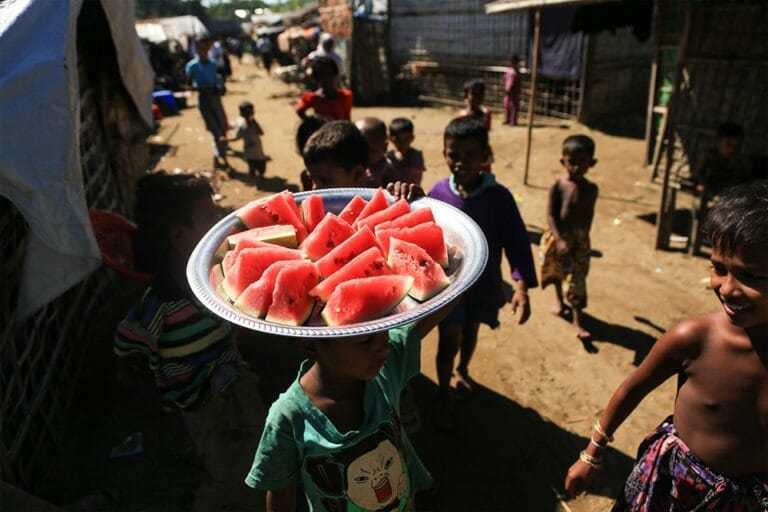
Children selling watermelon, Rakhine State Myanmar
Myanmar
Myanmar has so far appeared relaxed about the coronavirus, even though only very limited testing has been carried out. Last week, Aung San Suu Kyi told the public that Covid-19 has yet to reach the country. According to Zaw Htay, a Myanmar government spokesperson, this comes down to the local diet and lifestyle, which are “beneficial against the coronavirus.”
But fear lingers that some cases might be going undetected, as three of the country’s neighbors – China’s Yunnan province, Bangladesh and Thailand – have been affected. Limited access to healthcare facilities and isolation for many rural communities means we know little about what is going outside urban centers. When an outbreak of measles in the western Naga region erupted in 2016, for instance, initial assistance only came a week after the local village chief asked for help. By then, dozens were reportedly dying.
A silent epidemic, spreading quietly through asymptomatic patients and then ballooning suddenly – something that might have happened in Italy, where experts say the virus probably started circulating long before it was first detected – would put immense pressure on the nation’s healthcare system.
Medical services are already stretched in cities, but the situation worsens as one moves toward the border areas, which have been ravaged by the world’s longest civil war. Lack of infrastructure and funding affects all of the many internally displaced persons and refugee camps both inside and outside the country.
Over 900,000 Rohingya refugees are trapped in what the UN describes as “extremely congested camps” on Bangladeshi soil. According to Doctors Without Borders, the situation there is “extremely precarious, with many people lacking access to healthcare, safe drinking water, latrines and food.”
Similar issues are evident on the eastern side of the country, where a series of camps along the Thai border host over 100,000 Karen refugees, and among displaced Kachin people in the north. Given the physical restrictions imposed by camp life, it is hard to imagine how any “social distancing” could possibly be implemented there, let alone emergency therapy for the sick.
Cambodia
Further east, in Cambodia, although the civil war thankfully ended decades ago, poverty survives, and the healthcare system is patchy. In spite of fast improvements over the years, Cambodians still have a lower life expectancy than both Vietnam and Thailand, and it is not uncommon for families to fall into debt in order to afford cures when someone falls sick.
Hun Sen, the de-facto absolute leader of the country, has so far played down risks while using the pandemic to throw opposition activists and other expressing concern about the virus and the governments response in jail, according to Phil Robertson, deputy Asia director at Human Rights Watch. “The government should stop abusing people’s free speech rights and instead focus on providing the public with accurate and timely information about Covid-19.”
But as infections rise – 84 people have been found positive in the Kingdom – authorities are taking initial steps to curb the virus. Visitors from the United States, Italy, Spain, France and Germany have been barred entry for a month. Border crossings with Vietnam are not closed. Myanmar, too, is partially sealing its borders and calling off large scale events for the Buddhist New Year, which usually gathers people in the streets for water battles.
Asia Sentinel correspondent
* Opinions expressed in this article are the author’s own and do not necessarily reflect FORSEA’s editorial stance.
This article dated March 24, 2020 is republished from Asia Sentinel

